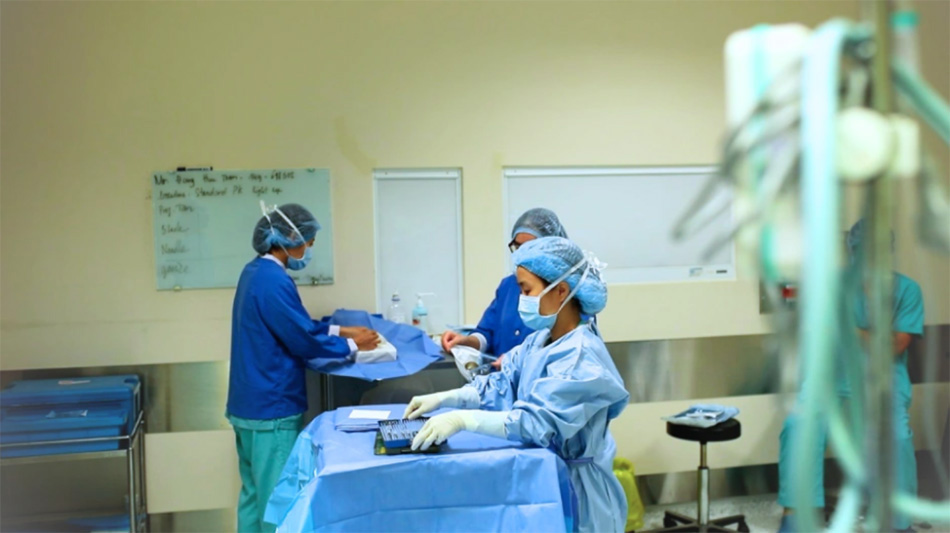Childhood cataracts are a vision impairment disease that is easily overlooked because most people believe this condition only occurs in older adults. If not detected and treated early, a child’s vision can deteriorate severely, potentially leading to blindness.

A doctor performs a preoperative examination for a young patient with cataracts
A 5-year-old boy is near-sighted with a prescription of -7.00 diopters and has amblyopia due to cataracts.
At the age of 5, Tek (from Cambodia) frequently fell while playing with friends. Suspecting that he inherited cataracts from his father, the family decided to take him to FV Hospital in Vietnam for an examination.
Tests revealed that Tek had severe myopia of -7.00 diopters along with amblyopia, with vision in both eyes reduced to 1/10. Dr Hoang Chi Tam, Ophthalmology & Refractive Surgery Department at FV Hospital stated that the cause of Tek’s severe vision impairment was due to congenital cataracts that had not been treated in time.

Simulation of a normal eye and an eye with cataracts
The lens is a transparent, biconvex structure located behind the iris (also known as the pupil), which functions to regulate and focus light onto the retina, allowing us to see objects clearly. When the lens becomes cloudy, making it difficult for light to pass through and focus on the retina, this condition is known as cataracts.
Dr Hoang Chi Tam said, “Many people still mistakenly believe that cataracts, also known as senile cataracts, only occur in adults due to the aging process. However, it is not uncommon for children to be born with this condition. If children with cataracts are not treated promptly, they can cause significant vision impairment, leading to amblyopia. Additionally, children with cataracts may experience reduced physical activity, resulting in slower cognitive development.”
Phaco Surgery for Cataract Treatment: Safe and Painless
For cataracts affecting a child’s vision, the only solution is surgery to replace the cloudy lens with a suitable artificial lens. Typically, examining and advising cataract surgery for children is challenging as young patients may not cooperate with doctors, and anaesthesia for young children must be performed safely.

FV’s experienced team of anaesthesiologists provides strong support for paediatric cataract surgery
To recommend surgery, the patient must undergo a preoperative examination. At FV Hospital, paediatric patients are examined preoperatively by a team of professional and experienced medical staff who ensure the child’s cooperation throughout the process. FV’s modern equipment supports accurate vision measurement for children, including devices such as the lens power meter for selecting the most suitable artificial lens, the endothelial cell counter for measuring and evaluating the number of endothelial cells in the cornea, and the fundus OCT scanner for detecting retinal and optic nerve diseases.
Based on the preoperative examination results, the child will be prescribed the appropriate lens for the surgery. FV Hospital currently uses two types of artificial lenses: monofocal and multifocal (or extended depth of focus).
In the case of the patient Tek, Dr Hoang Chi Tam chose to implant a multi-focal intraocular lens to provide the child with vision at various distances. After the surgery, patient Tek was discharged on the same day. Nineteen days later, patient Tek returned for a follow-up and had surgery on the other eye. After completing both surgeries, Tek’s family was delighted to see an improvement in vision from 1/10 to 5/10. Tek was also given instructions to undergo amblyopia training as per Dr.Tam’s recommendations to further improve vision.
According to Dr Tam, FV Hospital is also a pioneer in using the femtosecond low-energy laser system for treatments in adults and potentially in children. The advantages of the femtosecond low-energy laser include performing surgical procedures such as creating incisions, capsulotomy (opening the lens capsule), and lens fragmentation with precision, safety, and faster postoperative recovery.
Dr Tam added “Cataract surgery with the femtosecond laser is not just for cataract removal but also refractive surgery. By using the laser for precise adjustments, patients post-surgery will experience significant reduction or elimination of astigmatism and refractive errors such as presbyopia and myopia, thanks to the precise calculation of the intraocular lens power.”

Patients at FV undergo cataract surgery in an operating room that meets international JCI medical standards
How to Detect Cataracts Early in Children?
Statistics show that approximately 0.4% of children are born with congenital cataracts or develop them early. Parents should take their children for an eye examination if there is a family history of the condition. “Additionally, cases where the child is born prematurely, or the mother had prenatal complications related to infections, premature rupture of membranes, etc., should also be examined after birth to rule out cataracts,” advises Dr Tam.

To recognize cataract syndrome in children, Dr Hoang Chi Tam advises parents to observe their child’s eyes.
According to Dr Tam, to identify cataracts in children, parents should observe the child’s pupils. If the pupils are clear, it is normal; if there are cloudy white spots, the child may have an eye problem. Furthermore, the eye movements of children with cataracts will be slower, with less frequent side-to-side movement, or difficulty focusing on objects; these children often fumble and have better near vision than distance vision.
Another way to detect cataracts is by taking a photo of the child using a phone flash and checking the image for red reflex in the pupil. If there is a red reflex, it is a good sign, as the flash reflects off the blood-rich retinal layer, resulting in a pink or red colour. If there is no red reflex, the child may have cataracts or another eye condition, and an eye examination and treatment should be sought as soon as possible.
For more information on paediatric cataract surgery, please contact Ophthalmology & Refractive Surgery Department, FV Hospital at: (028) 54 11 33 33.



